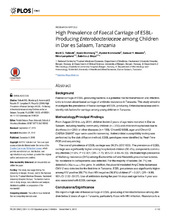| dc.contributor.author | Tellevik, Marit Gjerde | en_US |
| dc.contributor.author | Blomberg, Bjørn | en_US |
| dc.contributor.author | Kommedal, Øyvind | en_US |
| dc.contributor.author | Maselle, Samuel Y | en_US |
| dc.contributor.author | Langeland, Nina | en_US |
| dc.contributor.author | Moyo, Sabrina John | en_US |
| dc.date.accessioned | 2017-08-04T09:22:51Z | |
| dc.date.available | 2017-08-04T09:22:51Z | |
| dc.date.issued | 2016-12-09 | |
| dc.Published | Tellevik MG, Blomberg B, Kommedal Ø, Maselle SY, Langeland N, Moyo SJ. High prevalence of faecal carriage of esbl-producing enterobacteriaceae among children in Dar es Salaam, Tanzania. PLoS ONE. 2016;11(12):e0168024 | eng |
| dc.identifier.issn | 1932-6203 | |
| dc.identifier.uri | https://hdl.handle.net/1956/16210 | |
| dc.description.abstract | Background: Faecal carriage of ESBL-producing bacteria is a potential risk for transmission and infection. Little is known about faecal carriage of antibiotic resistance in Tanzania. This study aimed to investigate the prevalence of faecal carriage of ESBL-producing Enterobacteriaceae and to identify risk factors for carriage among young children in Tanzania. Methodology/Principal: Findings From August 2010 to July 2011, children below 2 years of age were recruited in Dar es Salaam, including healthy community children (n = 250) and children hospitalized due to diarrhoea (n = 250) or other diseases (n = 103). ChromID ESBL agar and ChromID CARBA SMART agar were used for screening. Antimicrobial susceptibility testing was performed by the disk diffusion method. ESBL genotypes were identified by Real-Time PCR and sequencing. The overall prevalence of ESBL carriage was 34.3% (207/ 603). The prevalence of ESBL carriage was significantly higher among hospitalized children (50.4%), compared to community children (11.6%; P < 0.001; OR = 7.75; 95% CI: 4.99–12.03). We found high prevalence of Multidrug-resistance (94%) among Escherichia coli and Klebsiella pneumoniae isolates. No resistance to carbapenems was detected. For the majority of isolates (94.7%) we detected a blaCTX-M-15-like gene. In addition, the plasmid mediated AmpC beta-lactamase CMY-2 was detected for the first time in Tanzania. ESBL prevalence was significantly higher among HIV positive (89.7%) than HIV negative (16.9%) children (P = 0.001; OR = 9.99; 95% CI: 2.52–39.57). Use of antibiotics during the past 14 days and age below 1 year was also associated with ESBL carriage. Conclusions/Significance: We report a high rate of faecal carriage of ESBL-producing Enterobacteriaceae among children below 2 years of age in Tanzania, particularly those with HIV-infection. Resistance to a majority of the available antimicrobials commonly used for children in Tanzania leaves few treatment options for infections when caused by these bacteria. | en_US |
| dc.language.iso | eng | eng |
| dc.publisher | PLOS | eng |
| dc.rights | Attribution CC BY | eng |
| dc.rights.uri | http://creativecommons.org/licenses/by/4.0 | eng |
| dc.title | High prevalence of faecal carriage of ESBL-producing enterobacteriaceae among children in Dar es Salaam, Tanzania | en_US |
| dc.type | Peer reviewed | |
| dc.type | Journal article | |
| dc.date.updated | 2017-05-10T09:06:16Z | |
| dc.description.version | publishedVersion | en_US |
| dc.rights.holder | Copyright 2016 The Author(s) | |
| dc.identifier.doi | https://doi.org/10.1371/journal.pone.0168024 | |
| dc.identifier.cristin | 1431281 | |
| dc.source.journal | PLoS ONE | |

